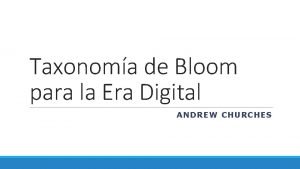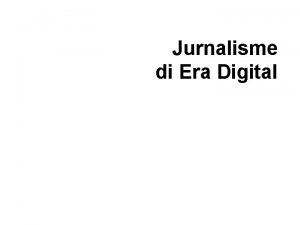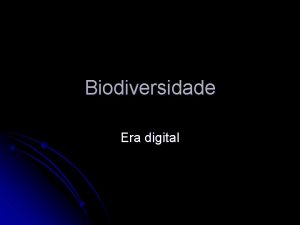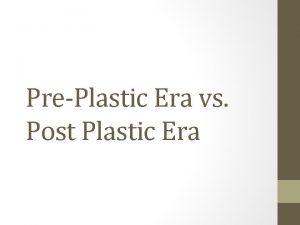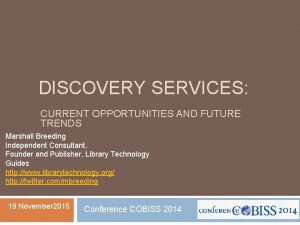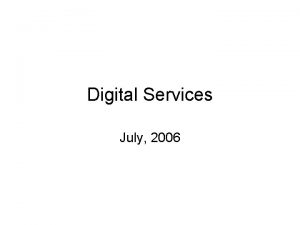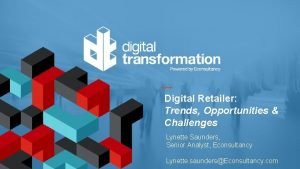Services in the Digital Era Trends and Opportunities






















- Slides: 22

Services in the Digital Era: Trends and Opportunities Sunil Johal @johalsunil

Highlighting Key Technological Trends 1

1. Digitization Firms in the digital economy are characterized by a number of key features: • • • Small physical infrastructure footprints Low costs of replication Rapid scalability Powerful network effects Low barriers to entry and constant development of new business models 2

Light Footprint; Massive Scale Fewer full-time employees, in part due to technological advancements that enable higher productivity. • For example, AT&T was America’s most valuable corporation in 1964, worth USD $267 billion (adjusted) with 758, 611 employees • Today, technology giant Google is valued at USD $370 billion with only 55, 000 employees 3

2. Platforms, P 2 P and Decentralization Marketplaces/platforms that allow people to: • buy goods and services directly from one another, instead of from traditional businesses • share the same assets on a rental/time-share basis, rather than buying Internet of Things (Io. T) will require decentralized, P 2 P, machine-to-machine communication Blockchain could replace/disrupt trusted intermediaries 4

P 2 P Platforms, everywhere Transportation Ridesharing (Uber, Lyft) and carsharing (Zipcar, Autoshare) Retail Independent producers and sellers connect directly with buyers (Etsy, e. Bay, Craigslist) Accommodation Peer-to-peer home sharing as an alternative to hotel (Airbnb, VRBO) Services On-demand services – Handy (home repair), Taskrabbit (various services) Finance Peer-to-peer financing/ investments (Indiegogo, Kickstarter) and lending (Prosper, Borrowell) 5

3. Artificial Intelligence and Automation AI is basis for wide-range of mainstream technologies, including web search, medical diagnosis, smart phone applications Deep learning – dramatically improved pattern recognition, speech recognition and natural language processing 6

Automation of industry – routine vs non-routine tasks 7

Implications of These Trends for Service Providers 8

What’s the impact? • • Increased uncertainty Increased pace of change Constant disruption and volatility Significant pressure on existing regulatory/social and economic frameworks • Increased need for quick, flexible and coordinated responses 9

Innovative Responses 10

1. Nudge Units Behavioural economics: Understanding the cognitive biases, habits and emotions that shape human decision-making. Nudging: Attempts to influence people’s behaviour by using small prompts or changing the way options are presented to people. Nudges are designed using insights from behavioural economics and other related disciplines (e. g. psychology). 11

In practice Intervention Lever Prompt Result Tax compliance Social norms Letter informing people in the UK that the majority of people in their area had already paid their taxes on time. Payment rates increased by 15 percentage points Prompt when renewing vehicle tax or applying for a driving licence online in England: 1, 203 more people registered than control group (n=135, 000) “If you needed an organ transplant, would you have one? If so please help others. ” If rolled out nationally: an additional 96, 000 registrations a year Organ donation Reciprocity If rolled out nationally: additional revenue of £ 30 million 12

2. Integrated Service Delivery Identifying opportunities to make service delivery more efficient and effective can involve: ü Co-location of services ü Streaming clients ü Inter-governmental collaboration ü Focus on outcomes 13

Key Drivers The delivery of human and social services is being put under strain by a range of external forces (drivers): §ECONOMIC PRESSURES: Global financial crisis, unemployment, and rising demand for services. §DEMOGRAPHIC CHANGE: Population movement, aging populations, rising inequality, and intergenerational disadvantage. §EVOLVING EXPECTATIONS: New technologies and a rebalancing of power. 14

3. Outcomes funding • There is a growing trend to focus on performance and quality of services rather than quantity • However, measuring outcomes is more challenging than measuring outputs Services have traditionally been measured and funded based on outputs INPUT ACTIVITY OUTPUT OUTCOME The resources that enable a service to operate The specific intervention(s) delivered by a service provider The direct products delivered by a service provider The impact of an intervention on the lives of service users 15

Potential to transform service delivery ü Strengthening the use of evidence in practice ü Promoting innovation (cost-effective way of sponsoring R&D) ü Realigning incentives (correcting past focus on compliance instead of policy objectives) ü Incentivizing holistic support and client-centred services ü Improving accountability 16

Types of outcomes funding There are four main outcomes funding models: 1. Payment-forperformance • At least a portion of funding is only paid if service providers achieve outcomes targets 2. Social impact bonds • Paying private investors a dividend if the interventions they sponsor improve client outcomes 3. Performancebased contracting • The redistribution of contracts among service delivery organizations on the basis of their track record 4. Performanceincentive funding • Service delivery providers are awarded bonus payments for improvements in client outcomes 17

4. Policy Labs & Design Thinking Collaborative spaces mixing policy and delivery stakeholders. Brainstorm and stress-test solutions. Success factors: ü Demonstrate quick, politically-salient results ü Departmental engagement strategies ü The right mix of staff (core team + secondment) 18

What do all these approaches have in common? ü Put yourself in the shoes of the citizen/client ü Measure and track priorities/progress ü Be creative about options and tools ü Avoid silos and territoriality joined-up responses 19

Emerging consensus around the future of government Reform efforts are coalescing around a number of broad trends: INTEGRATION Operations are integrated both within and across government departments CLIENT-CENTRED SERVICES Services are redesigned around the needs of the end user PARTNERED DELIVERY Responsibility for service delivery is shared with providers from the nonprofit and private sectors A FOCUS ON OUTCOMES The procurement of services on the basis of outcomes rather than process or method DIGITIZATION The adoption of new digital technologies that lower transaction costs and respond to evolving citizen expectations 20

Questions & Discussion @johalsunil@mowatcentre. ca 21
 Observing trends in entrepreneurship example
Observing trends in entrepreneurship example Quiz 2 the baroque era
Quiz 2 the baroque era Elizabethan era vs victorian era
Elizabethan era vs victorian era Creí que era una aventura y en realidad era la vida
Creí que era una aventura y en realidad era la vida Era uma estrela tão alta era uma estrela tão fria
Era uma estrela tão alta era uma estrela tão fria Taxonomía de bloom en la era digital pdf
Taxonomía de bloom en la era digital pdf Peran akuntansi sektor publik di era digital
Peran akuntansi sektor publik di era digital Los retos escolares en la era digital
Los retos escolares en la era digital Digital goods ecommerce
Digital goods ecommerce Hình ảnh bộ gõ cơ thể búng tay
Hình ảnh bộ gõ cơ thể búng tay Frameset trong html5
Frameset trong html5 Bổ thể
Bổ thể Tỉ lệ cơ thể trẻ em
Tỉ lệ cơ thể trẻ em Chó sói
Chó sói Tư thế worm breton
Tư thế worm breton Alleluia hat len nguoi oi
Alleluia hat len nguoi oi Môn thể thao bắt đầu bằng chữ đua
Môn thể thao bắt đầu bằng chữ đua Thế nào là hệ số cao nhất
Thế nào là hệ số cao nhất Các châu lục và đại dương trên thế giới
Các châu lục và đại dương trên thế giới Công thức tính thế năng
Công thức tính thế năng Trời xanh đây là của chúng ta thể thơ
Trời xanh đây là của chúng ta thể thơ Mật thư anh em như thể tay chân
Mật thư anh em như thể tay chân Phép trừ bù
Phép trừ bù





